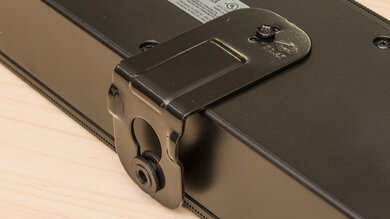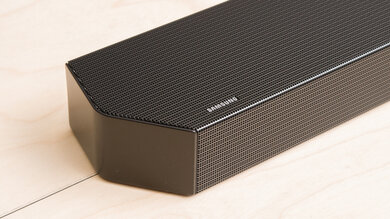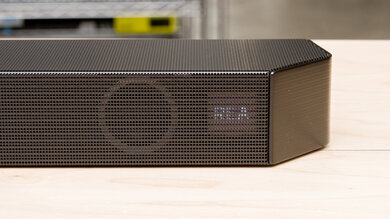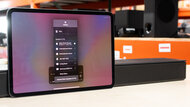The Samsung HW-Q60B is a simple 3.1 setup released as part of Samsung's 2022 soundbar lineup. It comes with a dedicated subwoofer, and you can add on separate rear speakers if you want to enhance its surround sound. It also supports Samsung's Q-Symphony technology, which lets you pair the bar with a compatible Samsung TV to use the bar's speakers in tandem with the TV's speakers. It's advertised to have two up-firing channels, which seem to be related to Samsung's Acoustic Beam technology, but they don't play sound like more traditional up-firing height drivers. Overall, it doesn't offer as many features as Samsung's more premium models, like the Samsung HW-Q990B - for example, there's no room correction feature or voice assistant support, and you can't control it using the SmartThings app.
Our Verdict
The Samsung HW-Q60B is good for mixed usage. It's a simple 3.1 bar that has a pretty neutral sound out-of-the-box, so voices and lead instruments are clear and present in the mix. Like most Samsung models, it offers lots of customization tools, too, including a graphic EQ as well as lots of presets. While there's support for surround sound and Dolby Atmos, unfortunately, it has to downmix this content into stereo to play it. There's a lack of low-bass, too, that's noticeable with action-packed movies and bass-heavy music.
-
Graphic EQ.
-
Dolby Atmos support.
-
Dialogue enhancement feature.
-
Lacks some low-bass.
-
Downmixes surround and Atmos content into stereo.
The Samsung HW-Q60B is great for dialogue-focused content like TV shows and podcasts. It's a 3.1 setup with a discrete center channel that helps reproduce voices more clearly and accurately, and its balanced mids ensure that dialogue is detailed and present in the mix. You can also use its 'Adaptive Sound' dialogue enhancement feature if you want, or its Night Mode to balance the volume level for dialogue clarity when you watch TV at night.
-
Dialogue enhancement feature.
-
Night mode available.
-
No Wi-Fi, Apple Airplay, or Chromecast support.
The Samsung HW-Q60B is good for music. Its default sound is pretty neutral, especially in the mids where more voices and lead instruments are reproduced. There's a little extra boom in the high-bass that adds a nice rumble. You have lots of customization tools on hand, including bass and treble adjustments as well as a 7-band graphic EQ. However, its low-frequency extension isn't the most impressive, so you don't feel the deep thump in bass-heavy music like EDM and hip-hop.
-
Bass and treble adjustments.
-
Graphic EQ.
-
Lacks some low-bass.
The Samsung HW-Q60B is decent for movies. It supports Dolby Atmos as well as surround sound content like Dolby Digital, which you find on lots of streaming platforms and Blu-ray discs. However, it has to downmix this content into stereo to play it, which doesn't sound as immersive as setups with discrete surround speakers or up-firing height drivers. The lack of low-bass means that you don't feel the deep thump in action-packed scenes or intense scores, either.
-
Graphic EQ.
-
Dolby Atmos support.
-
Lacks some low-bass.
-
Downmixes surround and Atmos content into stereo.
- 7.5 Mixed Usage
- 8.0 Dialogue/TV Shows
- 7.4 Music
- 7.2 Movies
Changelog
- Updated Jul 28, 2023: We updated the Stereo Soundstage score from 7.0 to 6.5. This is a subjective evaluation, and testing the next gen Samsung HW-Q60C gave us a better point of comparison. We also corrected an error in the bar's height in Dimensions - Bar.
- Updated Jul 25, 2023: Added market comparison with the Samsung HW-Q60C in the Stereo Frequency Response box.
- Updated Jul 06, 2023: Thanks to user feedback, we identified the Samsung HW-Q67CB as a Costco-exclusive variant of this soundbar.
- Updated Jun 28, 2023: Added a market comparison with the Sony HT-S2000 to the Sound Enhancement Features box.
- Updated Jun 12, 2023: Updated the 4k Max Refresh Rate result to 60Hz.
Check Price
Differences Between Sizes And Variants
The Samsung HW-Q60B is available in 'Black', and you can see the label for the model we tested here. You can find a version of this soundbar at Costco called the Samsung HW-Q67CB. It's the same bar and subwoofer, but it also comes with satellites.
If you encounter another version of this soundbar, let us know in the discussions, and we'll update our review.
Compared To Other Soundbars
The Samsung HW-Q60B is a simple 3.1 bar ideal for listening to music and vocal-centric content like TV shows. Like most Samsung bars, it comes with lots of customization tools to help you adjust its sound to your liking. However, it lacks more premium features like room correction, and it has to downmix 5.1 surround sound and Dolby Atmos content into stereo to play it.
Make sure to also check out our recommendations for the best Samsung soundbars, the best Dolby Atmos soundbars, and the best soundbars for dialogue.
The Samsung HW-Q60B is a more versatile 3.1 bar than the Samsung HW-B650, especially for movie lovers. Unlike the B650, the Q60B supports Atmos content. It has to downmix it into stereo to play it, though. If you watch a lot of Atmos movies on streaming platforms, go with the Q60B, but if you don't watch them, the B650 is a better value.
The Samsung HW-Q60C/Q6CC is the next generation of the Samsung HW-Q60B. Both bars have similar designs and similar overall performances regarding their sound. However, the Q60C offers a few improvements, notably with low-frequency extension.
The Samsung HW-Q60B is a better 3.1 setup than the Sony HT-S2000. Since it comes with a dedicated subwoofer, it offers better bass reproduction. It comes with more features, too, such as a graphic EQ for sound customization and an HDMI input for video passthrough.
The Samsung HW-Q60B is better than the LG S65Q. They're both 3.1 setups, but the Samsung supports Dolby Atmos content, unlike the LG. It also comes with a few more customization tools, including a graphic EQ.
The Samsung HW-Q600A and the Samsung HW-Q60B are very similarly-performing soundbars, so depending on your listening habits, you may prefer one over the other. The Samsung HW-Q600A has a better Atmos performance thanks to its two up-firing drivers, which do a better job representing height sound effects. However, it doesn't have eARC support like the HW-Q60B, which is disappointing if you're looking to access more formats via your TV.
The Samsung HW-Q60B is better than the Samsung HW-B450. The HW-Q60B is a 3.1 setup with Dolby Atmos support, unlike the B450. It's better built, too, and it comes with more sound enhancement features, like a graphic EQ. Dialogue is more clear thanks to its discrete center channel, and there are HDMI connections available, unlike the B450.
The Samsung HW-Q60B is better than the LG S75Q for most uses. The Samsung is a 3.1 setup, and it has a more neutral sound out-of-the-box, especially in the treble range. As a result, higher-pitched sounds like cymbals are more detailed in the mix. It has a graphic EQ for customization, too. However, the LG's better for Dolby Atmos content since it offers up-firing height drivers, while the Samsung's advertised up-firing drivers aren't for height content.
The Klipsch Cinema 800 is better than the Samsung HW-Q60B. They're both 3.1 setups with Dolby Atmos support, but the Klipsch offers a better soundstage. It's also able to reproduce a more extended low-bass, so you feel more thump and rumble in your audio. There are more wireless playback options on hand, too. That said, the Klipsch doesn't have a very premium build, especially compared to the Samsung.
The Samsung HW-Q60B is better than the Samsung HW-Q60T. Although the HW-Q60T is a 5.1 setup, its surround performance isn't very impressive. It also doesn't support Dolby Atmos content like the HW-Q60B does. Also, the HW-Q60B comes with eARC support, so you have more capabilities with compatible TVs.
The Samsung HW-Q800A is better than the Samsung HW-Q60B. They're both 3.1 setups, but the HW-Q800A comes with two up-firing drivers built into the bar for a better Atmos performance. It has a better soundstage, too, and it can reproduce a more extended low-bass. You also have more wireless playback options on hand.
The Samsung HW-Q700A and the Samsung HW-Q60B are very similarly-performing soundbars, so depending on your listening habits, you may prefer one over the other. The HW-Q700A is a better choice for Atmos thanks to its two up-firing drivers, which more clearly represent sound effects in height content. It has more wireless playback options, too, and a better soundstage. It doesn't reproduce as much bass out-of-the-box compared to the HW-Q60B, but you can correct this issue a bit with its subwoofer level adjustment feature.
The Samsung HW-Q800B is better than the Samsung HW-Q60B. The Q800B is a 5.1.2 setup, meaning that it has two side-firing drivers for surround sound content. As a result, 5.1 surround formats like Dolby Digital sound more clear and real. It's better for Atmos content, too, and it comes with more sound enhancement features as well.
The Samsung HW-Q60B and the Sony HT-A3000 are both 3.1 bars that can play Dolby Atmos content, though they have to downmix it into stereo to play it. The Samsung is more versatile, though, as it comes with an HDMI In port for video passthrough as well as more customization tools. Also, the Samsung soundbar's dedicated sub means it can reproduce a more extended low-bass.
Test Results
The Samsung HW-Q60B is made of similar materials compared to the Samsung HW-Q60T. It's made of good-quality plastic and a solid metal grille. However, unlike the Q60T, the sides are angled.
You can add on either the Samsung SWA-9200S or the SWA-9100S rear speaker kits if you want.
The Samsung HW-Q60B is a bit longer than the Samsung HW-Q60T due to the angled edges. It doesn't fit between the legs of a 55-inch TV, but it isn't very tall, so it shouldn't block your TV screen.
The Samsung HW-Q60B has good build quality. It's similar to the Samsung HW-Q60T, with a bar that's mostly made of plastic and a metal grille to protect the drivers inside. The sub's made of wood, which feels solid. However, the fabric in the front seems thin, and it collects dust easily.
The Samsung HW-Q60B has a good stereo frequency response. It has a fairly neutral sound out-of-the-box, with balanced mids that reproduce clear and accurate voices and lead instruments. There's a little extra boom in the high-bass which adds some rumble to the sound. It can't reproduce the deep thump in the low-bass common with bass-heavy genres like EDM and hip-hop. The next-generation Samsung HW-Q60C/Q6CC does a little better in this regard but still pales compared to more premium models. Fortunately, many customization tools are on hand, like a graphic EQ and presets, but you can't make it reproduce lower frequencies.
The Samsung HW-Q60B has a good stereo frequency response with calibration. If you set its bass to '-3' and its treble to '1', it has a more neutral and balanced sound profile, making it suitable for listening to a lot of different types of audio content. Balanced mids ensure voices and lead instruments are clear and detailed in the mix, and while the high-bass is present, it isn't as thumpy. You still won't get the deep rumble in the low-bass, so it's not ideal for bass-heavy music or action-packed movies.
The Samsung HW-Q60B has a fair stereo soundstage. The bar's soundstage isn't perceived to be any wider than the bar itself, and it doesn't have any tricks to make it seem wider than that. There's good focus, though, so sound objects like voices and instruments seem to come from accurate, pinpoint locations in the soundstage.
The Samsung HW-Q60B has a good stereo dynamics performance. The bar gets loud enough to fill large rooms and open spaces, and there's not too much compression when you push it to max volume. As a result, audio reproduction is clean and pure even at high volumes.
The Samsung HW-Q60B has a fair stereo THD performance. At normal listening volumes, distortion falls within good limits, so audio reproduction is clean and pure. There's a jump in THD across the range when you push the bar to max volume, though. That said, distortion is hard to hear with real-life content - audiophiles notice some unwanted frequencies at loud volume, but more casual listeners don't hear much of a difference.
The Samsung HW-Q60B has a good center channel performance. It's a 3.1 setup, meaning that it comes with a discrete center channel. As a result, voices are more clear and accurate in the mix, and they're more accurately localized within the soundstage.
The Samsung HW-Q60B has a poor surrounds performance, which is common for 3.1 setups. It doesn't come with discrete surround speakers, so it has to downmix 5.1 content into stereo to play it. The resulting sound isn't as immersive, and it just seems like audio is coming from speakers placed in front of you. You don't get the sense that action is taking place all around you with 5.1 movies and video games.
The Samsung HW-Q60B has a poor Atmos performance. Though it's advertised to come with up-firing channels, these aren't designed for height content - they seem to be part of the Acoustic Beam technology, and they don't play sound with height content specifically. The bar has to downmix Atmos content into stereo to play it. The resulting sound isn't as immersive, as it simply plays the file through the bar's left and right stereo speakers. Sounds seem localized to the front of the bar, and while it can achieve some height, you don't get the sense that action is happening all around you. For example, it doesn't seem like sound effects come from the sides or from behind you. That said, this is a pretty typical performance for a 3.1 bar.
The Samsung HW-Q60B has a decent selection of sound enhancement features, especially compared to similar 3.1 models like the Sony HT-S2000. You can customize its sound with its bass and treble adjustments as well as its 7-band graphic EQ. There are several preset modes, including 'Standard', 'Surround Sound', 'Game', 'Adaptive Sound', and 'DTS VIRTUAL:X'. 'Adaptive Sound' is a dialogue enhancement feature, and 'DTS VIRTUAL:X' is a virtual surround mode that creates a more 3D sound. Also, if you add on rear speakers, you can adjust their levels.
You can pair the bar with compatible Samsung TVs to use Q-Symphony. This feature is advertised to create a more immersive sound by using your TV speakers in tandem with the speakers in the bar itself. However, in practice, Q-Symphony results in a noticeable difference in volume between the speakers on the bar and the speakers in the TV, which is quite distracting. You don't need Q-Symphony to get an immersive sound; if anything, it degrades the overall audio quality.
You can wire the Samsung HW-Q60B to your TV using HDMI or Optical connections. There's also a Full HDMI In port, meaning you can use the bar as a hub between different devices like your PC and your TV.
The Samsung HW-Q60B has incredible audio format support via ARC. If you watch a lot of content on streaming platforms and Blu-ray discs, you're likely to come across formats like Dolby Digital and Dolby Atmos. The bar supports all of them.
The Samsung HW-Q60B has fantastic audio format support via Full HDMI In. It can playback common surround sound formats like Dolby Digital as well as lossless and object-based formats like Dolby Atmos.
The Samsung HW-Q60B supports both Dolby Digital and DTS over Optical. Dolby Digital is the most common surround sound format - and while DTS isn't used as much, it's the fallback for higher-quality DTS-HD MA, which you find on a lot of Blu-rays.
The Samsung HW-Q60B has a good latency performance. It has fairly low latency, so you don't notice a delay between the audio you hear and the video you see. Some apps and TVs compensate for latency differently, so your real-world experience can vary.
The Samsung HW-Q60B can passthrough some high-quality bandwidth signals, so when you connect it between your TV and your PC, text on the screen is clear and crisp. It can't passthrough 4k @ 120Hz, though, so you can only watch 4k content at a max refresh rate of 60Hz, which doesn't appear as natural-looking.
You can wirelessly stream audio from your mobile devices to the bar via Bluetooth, and you can actually connect up to two devices at once. If you have certain Samsung mobile devices, you can use Samsung's Tap Sound feature, which mirrors sound from the device to the bar when you tap them against each other. If you don't have this feature, Bluetooth is still available.
Comments
Samsung HW-Q60B: Main Discussion
Let us know why you want us to review the product here, or encourage others to vote for this product.
Update: We updated the Stereo Soundstage score from 7.0 to 6.5. This is a subjective evaluation, and testing the next gen Samsung HW-Q60C gave us a better point of comparison. We also corrected an error in the bar’s height in Dimensions - Bar.






































